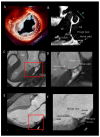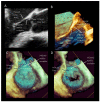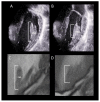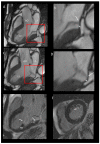Anatomy of Mitral Valve Complex as Revealed by Non-Invasive Imaging: Pathological, Surgical and Interventional Implications
- PMID: 33158082
- PMCID: PMC7712333
- DOI: 10.3390/jcdd7040049
Anatomy of Mitral Valve Complex as Revealed by Non-Invasive Imaging: Pathological, Surgical and Interventional Implications
Abstract
Knowledge of mitral valve (MV) anatomy has been accrued from anatomic specimens derived by cadavers, or from direct inspection during open heart surgery. However, today two-dimensional and three-dimensional transthoracic (2D/3D TTE) and transesophageal echocardiography (2D/3D TEE), computed tomography (CT) and cardiac magnetic resonance (CMR) provide images of the beating heart of unprecedented quality in both two and three-dimensional format. Indeed, over the last few years these non-invasive imaging techniques have been used for describing dynamic cardiac anatomy. Differently from the "dead" anatomy of anatomic specimens and the "static" anatomy observed during surgery, they have the unique ability of showing "dynamic" images from beating hearts. The "dynamic" anatomy gives us a better awareness, as any single anatomic arrangement corresponds perfectly to a specific function. Understanding normal anatomical aspects of MV apparatus is of a paramount importance for a correct interpretation of the wide spectrum of patho-morphological MV diseases. This review illustrates the anatomy of MV as revealed by non-invasive imaging describing physiological, pathological, surgical and interventional implications related to specific anatomical features of the MV complex.
Keywords: cardiac magnetic resonance; computed tomography; mitral valve anatomy; multimodality imaging; two-dimensional and three-dimensional transthoracic and transesophageal echocardiography.
Conflict of interest statement
The authors declare no conflict of interest.
Figures











Similar articles
-
Head-to-head comparison of two- and three-dimensional transthoracic and transesophageal echocardiography in the localization of mitral valve prolapse.J Am Coll Cardiol. 2006 Dec 19;48(12):2524-30. doi: 10.1016/j.jacc.2006.02.079. Epub 2006 Nov 28. J Am Coll Cardiol. 2006. PMID: 17174193
-
Transthoracic echocardiography in patients undergoing mitral valve repair: comparison of new transthoracic 3D techniques to 2D transoesophageal echocardiography in the localization of mitral valve prolapse.Int J Cardiovasc Imaging. 2018 Jul;34(7):1099-1107. doi: 10.1007/s10554-018-1324-2. Epub 2018 Feb 26. Int J Cardiovasc Imaging. 2018. PMID: 29484557
-
Real-time three-dimensional transesophageal echocardiography for assessment of mitral valve functional anatomy in patients with prolapse-related regurgitation.Am J Cardiol. 2011 May 1;107(9):1365-74. doi: 10.1016/j.amjcard.2010.12.048. Epub 2011 Mar 2. Am J Cardiol. 2011. PMID: 21371680
-
Anatomy of mitral annulus insights from non-invasive imaging techniques.Eur Heart J Cardiovasc Imaging. 2019 Aug 1;20(8):843-857. doi: 10.1093/ehjci/jez153. Eur Heart J Cardiovasc Imaging. 2019. PMID: 31219549 Review.
-
Management of mitral stenosis using 2D and 3D echo-Doppler imaging.JACC Cardiovasc Imaging. 2013 Nov;6(11):1191-205. doi: 10.1016/j.jcmg.2013.07.008. JACC Cardiovasc Imaging. 2013. PMID: 24229772 Review.
Cited by
-
Multimodality Imaging of the Anatomy of Tricuspid Valve.J Cardiovasc Dev Dis. 2021 Sep 3;8(9):107. doi: 10.3390/jcdd8090107. J Cardiovasc Dev Dis. 2021. PMID: 34564125 Free PMC article. Review.
-
The Link Between Left Atrial Longitudinal Reservoir Strain and Mitral Annulus Geometry in Patients with Dilated Cardiomyopathy.Biomedicines. 2025 Jul 17;13(7):1753. doi: 10.3390/biomedicines13071753. Biomedicines. 2025. PMID: 40722823 Free PMC article.
-
Echocardiographic quantification of mitral apparatus morphology and dynamics in patients with dilated cardiomyopathy.J Int Med Res. 2024 Feb;52(2):3000605231209830. doi: 10.1177/03000605231209830. J Int Med Res. 2024. PMID: 38318649 Free PMC article. Review.
-
Multimodality Imaging of the Anatomy of the Aortic Root.J Cardiovasc Dev Dis. 2021 May 4;8(5):51. doi: 10.3390/jcdd8050051. J Cardiovasc Dev Dis. 2021. PMID: 34064421 Free PMC article. Review.
References
-
- Faletra F.F., Leo L.A., Paiocchi V.L., Schlossbauer S.A., Pedrazzini G., Moccetti T., Ho S.Y. Revisiting Anatomy of the Interatrial Septum and its Adjoining Atrioventricular Junction Using Noninvasive Imaging Techniques. J. Am. Soc Echocardiogr. 2019;32:580–592. doi: 10.1016/j.echo.2019.01.009. - DOI - PubMed
-
- Faletra F.F., Ho S.Y., Regoli F., Acena M., Auricchio A. Real-time three-dimensional transesophageal echocardiography in imaging key anatomical structures of the left atrium: Potential role during atrial fibrillation ablation. Heart. 2013;99:133–142. doi: 10.1136/heartjnl-2011-301336. - DOI - PubMed
-
- Faletra F.F., Muzzarelli S., Dequarti M.C., Murzilli R., Bellu R., Ho S.Y. Imaging-based right-atrial anatomy by computed tomography, magnetic resonance imaging, and three-dimensional transoesophageal echocardiography: Correlations with anatomic specimens. Eur. Heart J. Cardiovasc. Imaging. 2013;14:1123–1131. doi: 10.1093/ehjci/jet081. - DOI - PubMed
Publication types
LinkOut - more resources
Full Text Sources

